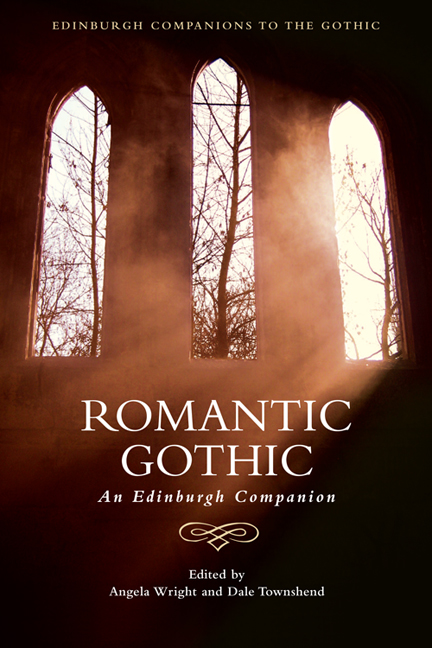Book contents
- Frontmatter
- Contents
- 1 Gothic and Romantic: An Historical Overview
- Part I Gothic Modes and Forms
- Part II National and International Borders
- Part III Reading the Romantic Gothic
- 15 Gothic and the Language of Terror
- 16 Gothic Science
- 17 Gender and Sexuality in Gothic Romanticism
- 18 Gothic Forms of Time: Architecture, Romanticism, Medievalism
- 19 Gothic Theology
- Notes on Contributors
- Index
19 - Gothic Theology
from Part III - Reading the Romantic Gothic
Published online by Cambridge University Press: 05 August 2016
- Frontmatter
- Contents
- 1 Gothic and Romantic: An Historical Overview
- Part I Gothic Modes and Forms
- Part II National and International Borders
- Part III Reading the Romantic Gothic
- 15 Gothic and the Language of Terror
- 16 Gothic Science
- 17 Gender and Sexuality in Gothic Romanticism
- 18 Gothic Forms of Time: Architecture, Romanticism, Medievalism
- 19 Gothic Theology
- Notes on Contributors
- Index
Summary
Ye are fallen, said I, ye dark and gloomy mansions of mistaken zeal, where the proud priest and lazy monk fattened upon the riches of the land, and crept like vermin from their cells to spread their poisonous doctrines through the nation … See how the pure light of heaven is clouded by the dim glass of the arched window, stained with the gaudy colours of monkish tales and legendary fiction; fit emblem how reluctantly they admitted the fairer light of truth amidst these dark recesses, and how much they have debased its genuine lustre. (Aikin and Aikin 1773: 89)
This invocation to the inhabitants of a ruined abbey sums up what is commonly believed to be the theology of the Gothic novel, combining as it does Protestant triumphalism and an Enlightenment critique of Catholicism as engendering superstitious darkness. It is undeniable that the Gothic heroine is at particular risk from the tyranny of monastic power and flees murderous monks in a Catholic country where the Roman faith still holds sway as the Gothic participates in what scholars now call ‘the long Reformation’ (Tyacke 2011), a process still not completed in the eighteenth century. In her essay on monastic institutions the poet Anna Laetitia Aikin similarly views the Reformation as ongoing, and the corruptions only ‘gradually clearing away’ in her own time (Aikin and Aikin 1773: 118). Such a perspective seems to differentiate Gothic from later Romantic poetic treatment of religion, such as William Wordsworth's 1802 sonnet's ‘quiet time […] holy as a Nun / Breathless with adoration’ (Wordsworth 1898: 224), or John Keats's pious beadsman in The Eve of St Agnes (1820). Yet not only does the beadsman die unmourned in a pile of ashes but Wordsworth's little daughter is more holy than a nun, since she lives in constant and unmediated converse with God. And Byron's disdain for superstition in Childe Harold's Pilgrimage (1812–18) is as thoroughgoing as that in Francis Lathom or Ann Radcliffe.
Aikin's essay, however, develops well beyond her initial deprecation of monastic life to develop a much more positive reading of its educational importance, practical social contribution and even its role as a secure resort for women.
- Type
- Chapter
- Information
- Romantic GothicAn Edinburgh Companion, pp. 361 - 376Publisher: Edinburgh University PressPrint publication year: 2015



